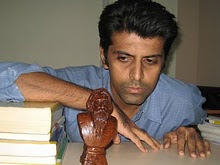Entering 2007
Hello All,
Let me wish all bloggers and all non-bloggers a very happy and successful New Year!
Looking back at 2006, I have had a typically mixed year - a job change, sporadic efforts at understanding more of Geometry, some equally sporadic efforts in running (the highlight being finishing a 10 km segment of the Pune Marathon), success in reaching a century of posts here (including the parallel 'Tech Musings' blog), a general decline in reading (no work of fiction was been read over the last year and more) and music appreciation (attended only one quality concert this year - when Rajan-Sajan Mishra visited Pune) and failure in the six kilo weight reduction effort which lasted the whole year but ended with the machine showing two kilos more than it did at the beginning. Traveling and trekking took a back-seat with only a drive into North Karnataka to show for the entire year (I have written about it elsewhere in this blog).
In 2007, I would love to do a lot of more Geometry and algorithms and to travel a bit more (and yes, I renew the resolution to kick those extra pounds). This blog is very likely to see less posts - hopefully I will be able to compensate somewhat by adding more serious stuff to 'Tech Musings'. In general, the blogging activity all over has ebbed from the crest of 2005 (and even prolific blogs like 'Locana', a serious immediate inspiration for self, have largely fallen silent) and I am only drifting with the trend...
Anyways, that is it, guys. Take care and be Good!
Let me wish all bloggers and all non-bloggers a very happy and successful New Year!
Looking back at 2006, I have had a typically mixed year - a job change, sporadic efforts at understanding more of Geometry, some equally sporadic efforts in running (the highlight being finishing a 10 km segment of the Pune Marathon), success in reaching a century of posts here (including the parallel 'Tech Musings' blog), a general decline in reading (no work of fiction was been read over the last year and more) and music appreciation (attended only one quality concert this year - when Rajan-Sajan Mishra visited Pune) and failure in the six kilo weight reduction effort which lasted the whole year but ended with the machine showing two kilos more than it did at the beginning. Traveling and trekking took a back-seat with only a drive into North Karnataka to show for the entire year (I have written about it elsewhere in this blog).
In 2007, I would love to do a lot of more Geometry and algorithms and to travel a bit more (and yes, I renew the resolution to kick those extra pounds). This blog is very likely to see less posts - hopefully I will be able to compensate somewhat by adding more serious stuff to 'Tech Musings'. In general, the blogging activity all over has ebbed from the crest of 2005 (and even prolific blogs like 'Locana', a serious immediate inspiration for self, have largely fallen silent) and I am only drifting with the trend...
Anyways, that is it, guys. Take care and be Good!

